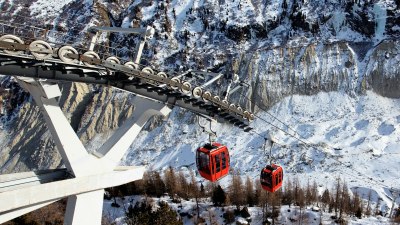Why Every Tourist Attraction Looks Smaller in Real Life
Discover the psychological and perceptual reasons why famous tourist attractions often seem smaller than expected.

Visiting iconic tourist attractions can be a once-in-a-lifetime experience. Travelers dream about the Eiffel Tower, the Grand Canyon, and the pyramids of Egypt, often building them up in their minds to an enormous scale. However, many find that when they finally arrive, these landmarks appear smaller than they envisioned. This phenomenon is due to a combination of psychological biases, perceptual illusions, and cultural expectations. In this article, we will delve into the reasons behind this intriguing discrepancy and offer insights into the perceptions of size in tourism.
Expectation vs. Reality
The gap between expectation and reality is one of the fundamental reasons why tourist attractions can appear smaller than anticipated. When individuals prepare for a trip, they consume media such as photographs, videos, and documentaries that showcase these sites. Often, these images are taken from flattering angles or include a wide perspective, which can amplify the perceived size of an object. Consequently, when tourists visit in person, they are faced with a facade that does not match the grandeur portrayed in the media. The difference between our mental image and the actual experience can lead to disappointment.
Psychological Factors at Play
Several psychological factors contribute to our perception of size. One important concept is the 'size constancy' effect, where our brains interpret objects as being a consistent size despite variations in distance. For instance, the further away an object is, the smaller it appears to the eye. Tourists viewing landmarks from a distance may interpret their size somewhat larger than they are; once they approach the structures, the shift in perception can lead to them appearing disproportionately smaller than expected.
Perception of Scale
Another fundamental aspect of perception is the context in which an object is viewed. Tourists might often view a well-known site in the company of crowds which provides a reference point, allowing them to contextualize its size. However, crowded spaces can create the illusion that attractions are smaller, as the overwhelming number of people distracts from their scale. The interaction with surrounding structures—buildings, trees, and even other tourists—affects how we gauge the size of an attraction.
Influence of Cultural Background
Culture plays a pivotal role in shaping our perceptions. For instance, in cultures where people are accustomed to vast natural landscapes, the scale of man-made structures like skyscrapers might seem diminutive by comparison. In contrast, individuals from urban environments might not feel the same sense of awe. This perceptual difference can alter expectations and affect one’s emotional experience upon seeing the attraction in person.
Architectural Expectations
In many cases, the architecture of famed tourist attractions is designed to be impressive. Designers often use techniques to give structures an illusion of grandeur. For example, tapering structures, high ceilings, and strategic use of symmetry can create a sense of height and importance. Once you’re up close, the perspective changes, and the details of the design can distract from the overall size, making the structure feel smaller. This phenomenon can be particularly pronounced with towers and monuments.
Photographic Representation
Today’s social media culture also plays a significant role in shaping perceptions. Photographers know how to use angles, distance, and framing to elevate a feeling of awe in their images, causing these places to appear larger-than-life. Social media users may post photographs taken deliberately to enhance the perception of scale, using filters and perspectives that add an artificial sense of grandeur.
The Psychological Effect of Closeness
When tourists approach landmarks, their brains process the proximity differently than when they view an object from afar; the closer you get, the more details become apparent. This shift can cause the overall perception of the structure's size to diminish. The mass of intricate carvings or features becomes more visible at close distances and may overshadow the primary impression one had from afar. Instead of an awe-inspiring giant, travelers may begin to see simply a large building filled with minutiae.
Comparative Analysis
Many iconic landmarks have other structures or geographical features nearby that can influence our understanding of their size. For instance, when visiting the Colosseum in Rome, there are numerous other buildings and ruins surrounding it that could shift your focus and provide a context. In contrast to its surrounding environment, the Colosseum may appear smaller than one might expect if that reference is not taken into consideration correctly.
Personal Experience and Expectations
Your personal experience before visiting can also shape your perception. Tourists often bring their own life experiences, size-related memories, or stories told to them that affect how they approach the actual site. A person who grew up in the shadow of a looming mountain range might find a monument far less impressive in comparison. Often, travel stories involving dreams of witnessing these iconic structures come layered with personal history, leading to either an inflated or deflated sense of expectation.
The Role of Marketing
Marketing strategies can also contribute to this phenomenon. Travel brochures and advertisements highlight the most stunning angles of these tourist attractions, carefully curated to invoke desire. The combination of appealing visuals, illustrious product descriptions, and stories over the years can distort the reality of what one can expect. The expectation becomes intertwined with visual representation that can set a heightened anticipation for visitors, ultimately leading to a stark contrast upon arrival.
Influences of Location
Location can also play a crucial role in how we perceive size. When landmarks are embedded within vast landscapes—like the Grand Canyon—there may be a tendency to feel small and insignificant rather than to appreciate the enormity of the Grand Canyon itself. In contrast, an object within a reflective environment might amplify feelings of grandeur, depending on the surrounding context.
Takeaway Lessons for Tourists
Understanding this perception can ultimately enhance one’s travel experience. By consciously recognizing these factors, tourists can mitigate their disappointment and adjust their expectations. Acknowledging that perception is subject to personal bias allows for a more open appreciation of what may come before them. Instead of focusing solely on size, travelers may begin to appreciate the intricate details, history, and cultural significance of what they are experiencing.
Asking Questions
Asking questions before visiting a site can also help with expectations. Researching and gathering insights from previous visitors can refine one’s perspective on the attraction’s significance, the details that matter, and how to approach it—be it with awe or respect.
Conclusion
Ultimately, the phenomenon of tourist attractions appearing smaller than expected is a complex interplay of cognitive psychology, perception, cultural context, media influence, and architectural design. By understanding these aspects, travelers can shape their expectations for a more fulfilling experience. Instead of solely focusing on physical size, one might discover deeper connections and appreciation for the extraordinary history and culture these landmarks represent.











